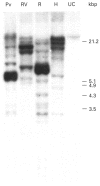Abstract
The cDNA designated celB from the anaerobic rumen fungus Neocallimastix patriciarum contained a single open reading frame of 1422 bp coding for a protein (CelB) of M(r) 53,070. CelB expressed by Escherichia coli harbouring the full-length gene hydrolysed carboxymethylcellulose in the manner of an endoglucanase, but was most active against barley beta-glucan. It also released reducing sugar from xylan and lichenan, but was inactive against crystalline cellulose, laminarin, mannan, galactan and arabinan. The rate of hydrolysis of cellulo-oligosaccharides by CelB increased with increasing chain length from cellotriose to cellopentaose. The predicted structure of CelB contained features indicative of modular structure. The first 360 residues of CelB constituted a fully functional catalytic domain that was homologous with bacterial endoglucanases belonging to cellulase family A, including five which originate from three different species of anaerobic rumen bacteria. Downstream from this domain, and linked to it by a serine/threonine-rich hinge, was a non-catalytic domain containing short tandem repeats, homologous to the C-terminal repeats contained in xylanase A from the same anaerobic fungus. Unlike previous fungal cellulases, genomic celB was devoid of introns. This lack of introns and the homology of its encoded product with rumen bacterial endoglucanases suggest that acquisition of celB by the fungus may at some stage have involved horizontal gene transfer from a prokaryote to N. particiarum.
Full text
PDF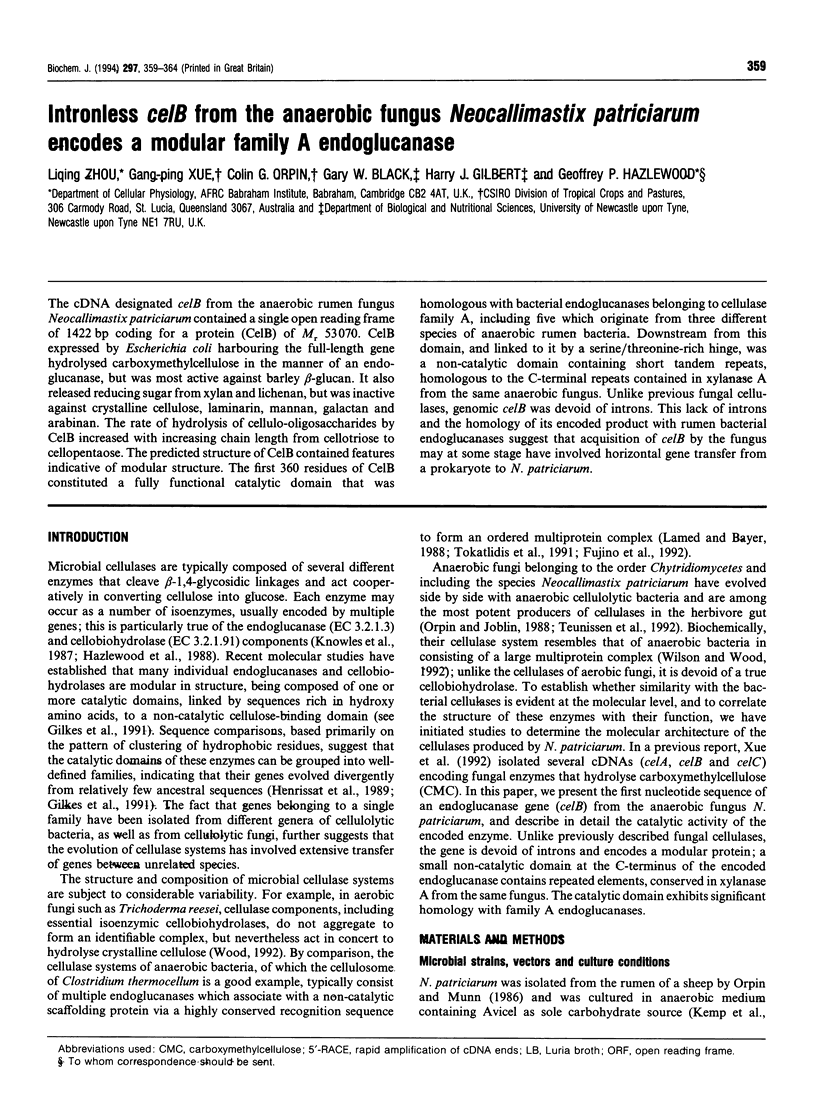
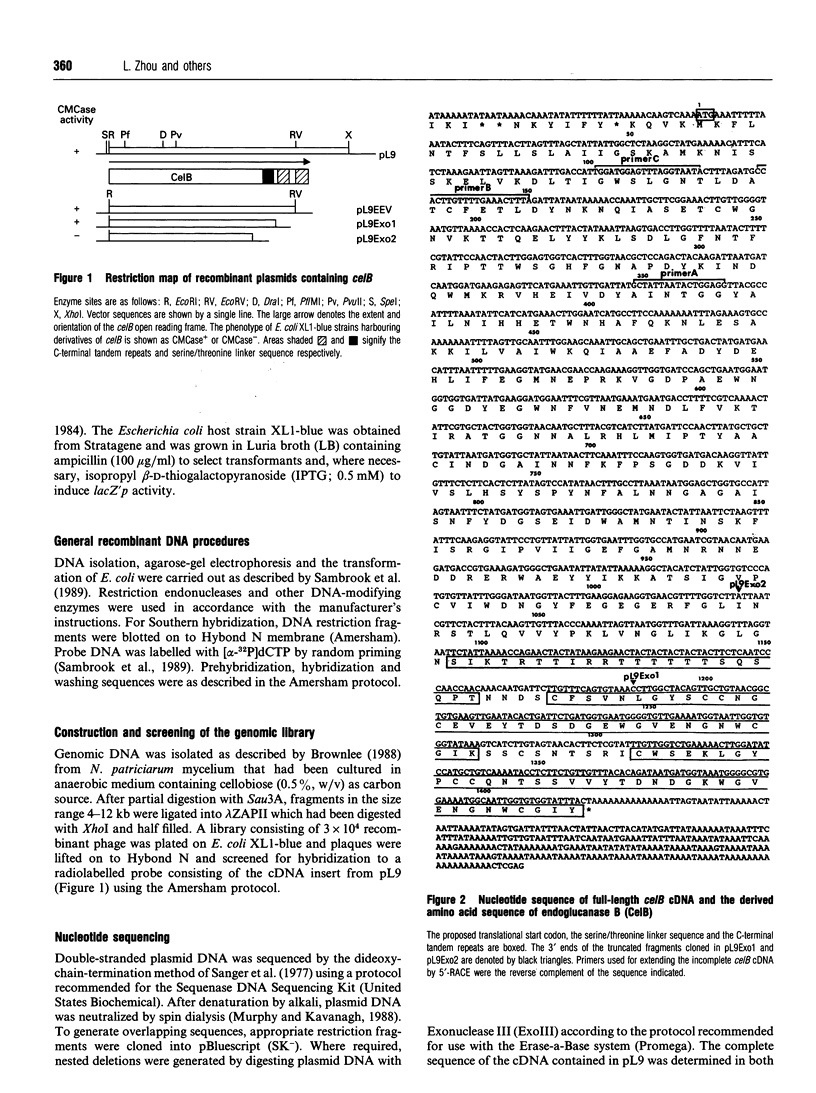
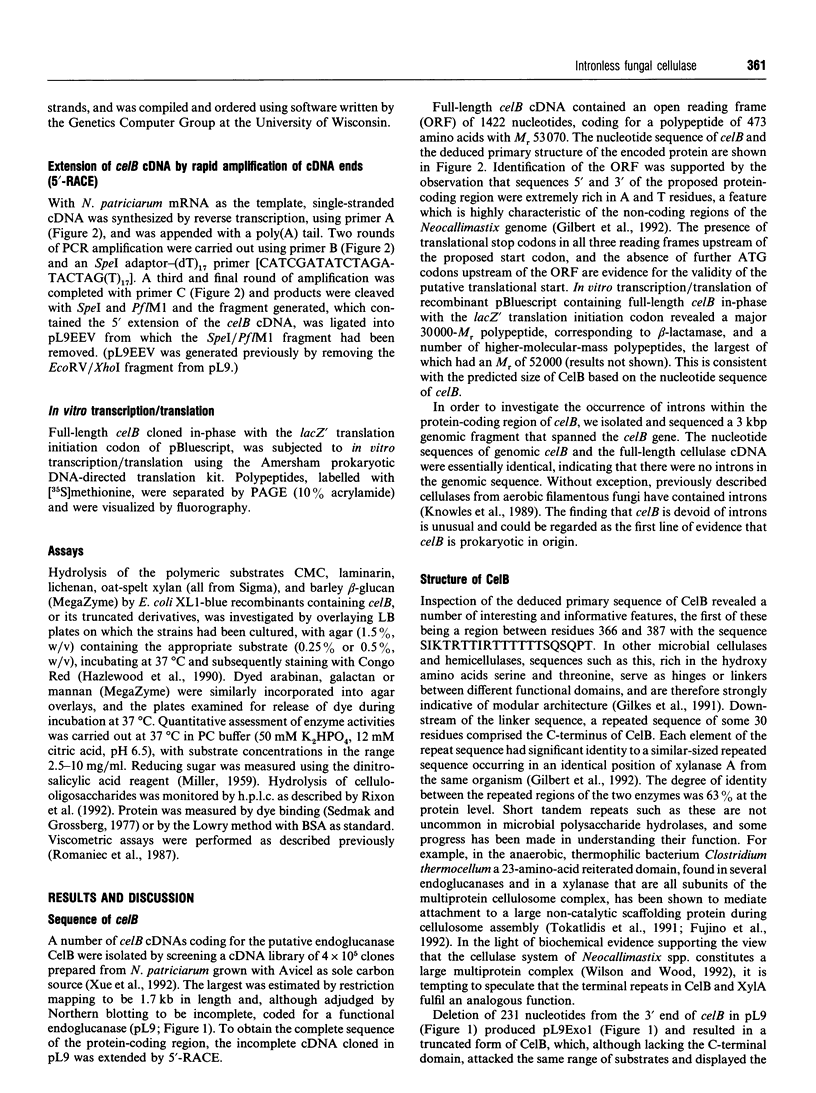
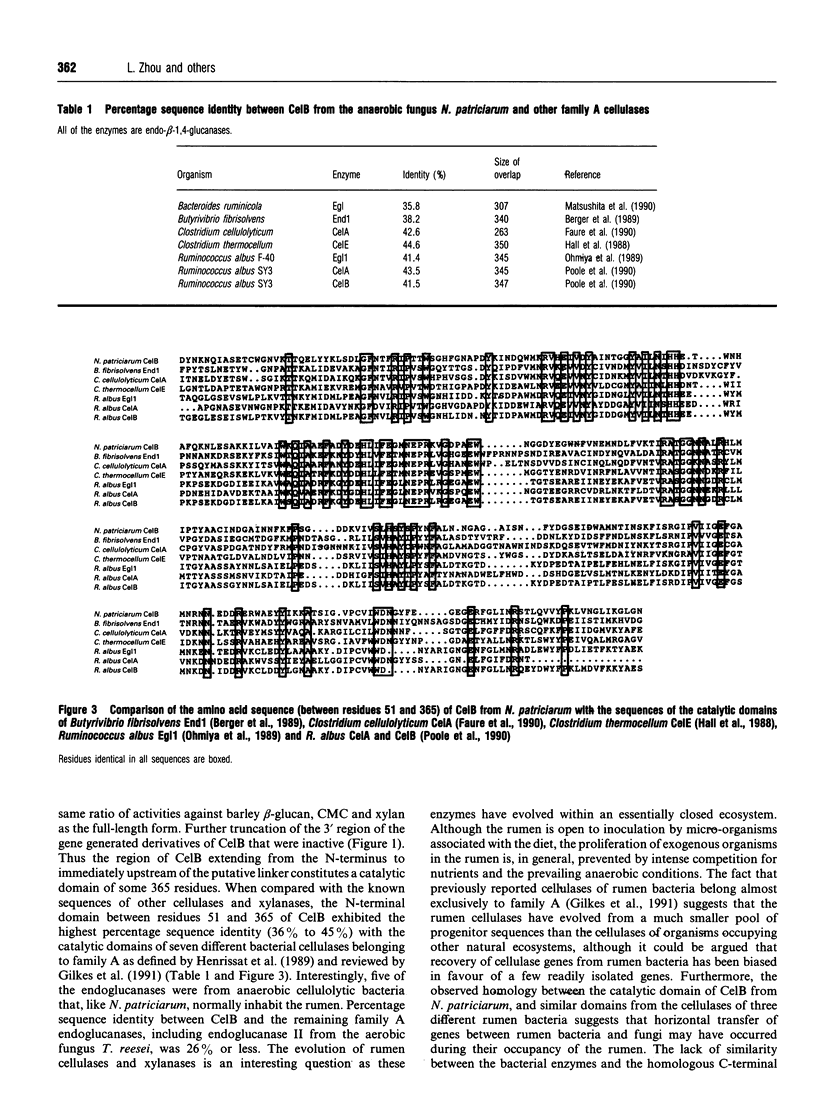
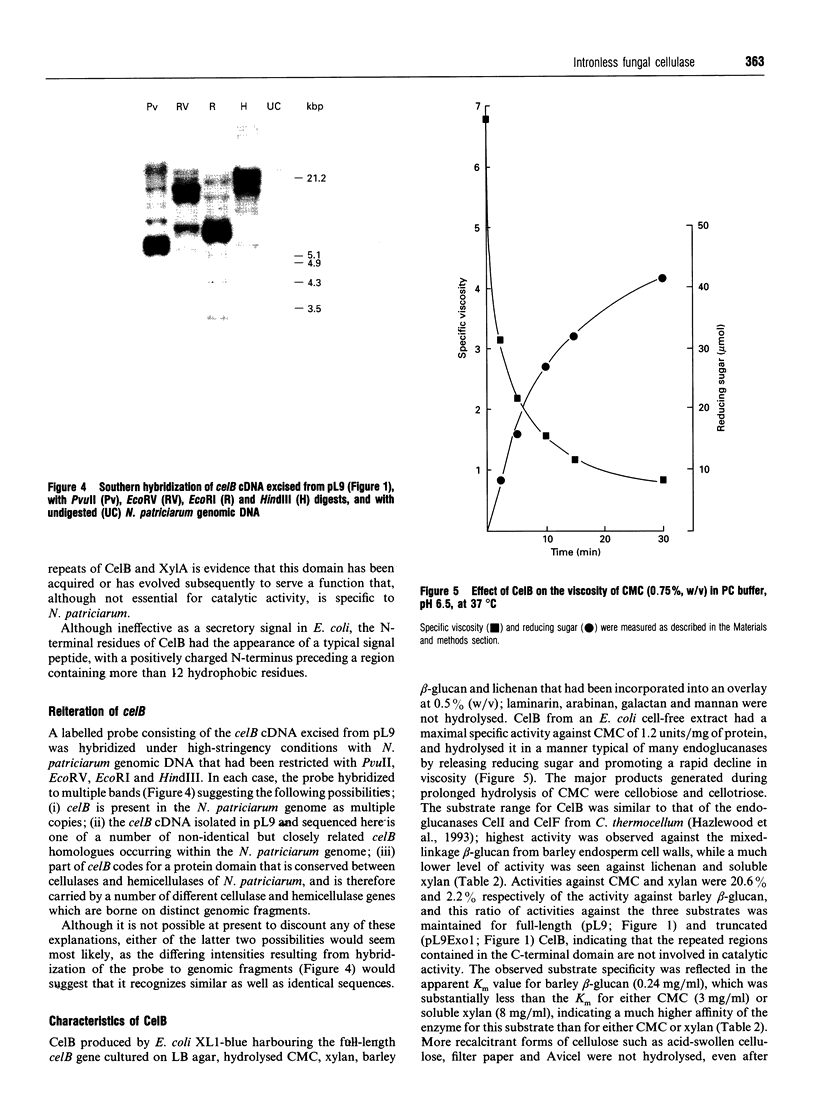
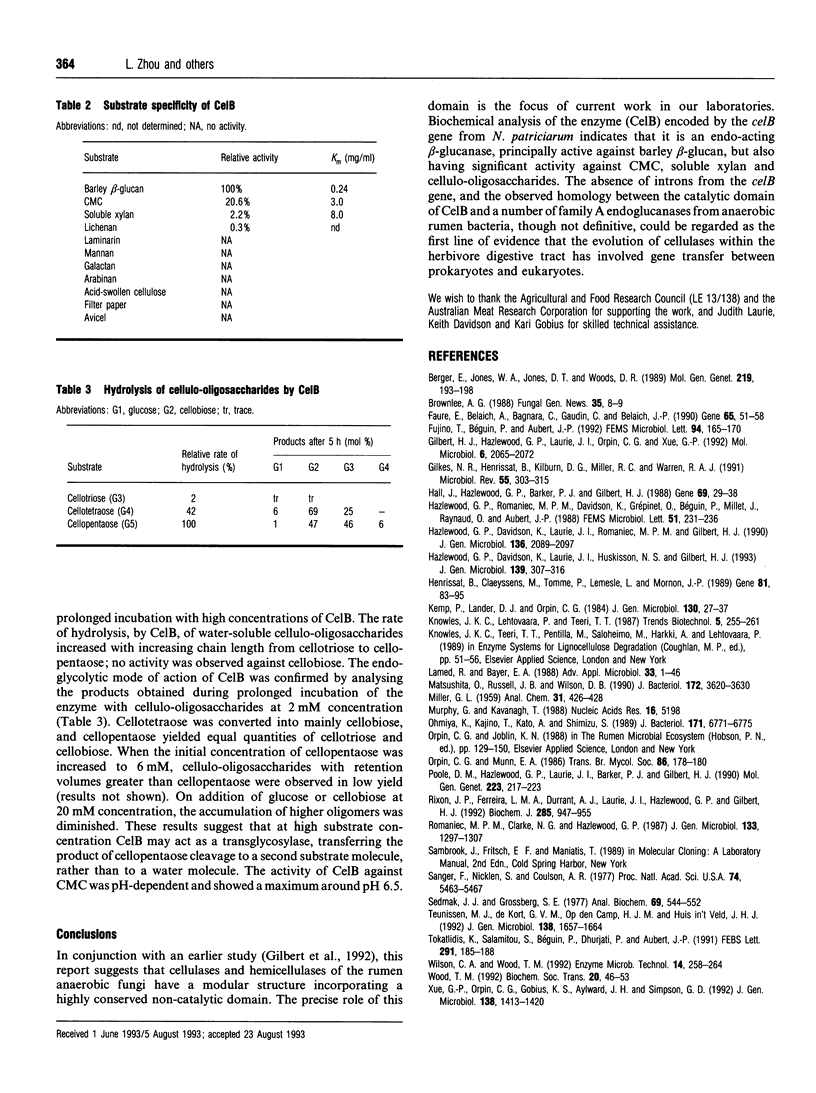
Images in this article
Selected References
These references are in PubMed. This may not be the complete list of references from this article.
- Berger E., Jones W. A., Jones D. T., Woods D. R. Cloning and sequencing of an endoglucanase (end1) gene from Butyrivibrio fibrisolvens H17c. Mol Gen Genet. 1989 Oct;219(1-2):193–198. doi: 10.1007/BF00261176. [DOI] [PubMed] [Google Scholar]
- Faure E., Bagnara C., Belaich A., Belaich J. P. Cloning and expression of two cellulase genes of Clostridium cellulolyticum in Escherichia coli. Gene. 1988 May 15;65(1):51–58. doi: 10.1016/0378-1119(88)90416-7. [DOI] [PubMed] [Google Scholar]
- Fujino T., Béguin P., Aubert J. P. Cloning of a Clostridium thermocellum DNA fragment encoding polypeptides that bind the catalytic components of the cellulosome. FEMS Microbiol Lett. 1992 Jul 1;73(1-2):165–170. doi: 10.1016/0378-1097(92)90602-k. [DOI] [PubMed] [Google Scholar]
- Gilbert H. J., Hazlewood G. P., Laurie J. I., Orpin C. G., Xue G. P. Homologous catalytic domains in a rumen fungal xylanase: evidence for gene duplication and prokaryotic origin. Mol Microbiol. 1992 Aug;6(15):2065–2072. doi: 10.1111/j.1365-2958.1992.tb01379.x. [DOI] [PubMed] [Google Scholar]
- Gilkes N. R., Henrissat B., Kilburn D. G., Miller R. C., Jr, Warren R. A. Domains in microbial beta-1, 4-glycanases: sequence conservation, function, and enzyme families. Microbiol Rev. 1991 Jun;55(2):303–315. doi: 10.1128/mr.55.2.303-315.1991. [DOI] [PMC free article] [PubMed] [Google Scholar]
- Hall J., Hazlewood G. P., Barker P. J., Gilbert H. J. Conserved reiterated domains in Clostridium thermocellum endoglucanases are not essential for catalytic activity. Gene. 1988 Sep 15;69(1):29–38. doi: 10.1016/0378-1119(88)90375-7. [DOI] [PubMed] [Google Scholar]
- Hazlewood G. P., Davidson K., Laurie J. I., Huskisson N. S., Gilbert H. J. Gene sequence and properties of CelI, a family E endoglucanase from Clostridium thermocellum. J Gen Microbiol. 1993 Feb;139(2):307–316. doi: 10.1099/00221287-139-2-307. [DOI] [PubMed] [Google Scholar]
- Hazlewood G. P., Davidson K., Laurie J. I., Romaniec M. P., Gilbert H. J. Cloning and sequencing of the celA gene encoding endoglucanase A of Butyrivibrio fibrisolvens strain A46. J Gen Microbiol. 1990 Oct;136(10):2089–2097. doi: 10.1099/00221287-136-10-2089. [DOI] [PubMed] [Google Scholar]
- Henrissat B., Claeyssens M., Tomme P., Lemesle L., Mornon J. P. Cellulase families revealed by hydrophobic cluster analysis. Gene. 1989 Sep 1;81(1):83–95. doi: 10.1016/0378-1119(89)90339-9. [DOI] [PubMed] [Google Scholar]
- Kemp P., Lander D. J., Orpin C. G. The lipids of the rumen fungus Piromonas communis. J Gen Microbiol. 1984 Jan;130(1):27–37. doi: 10.1099/00221287-130-1-27. [DOI] [PubMed] [Google Scholar]
- Matsushita O., Russell J. B., Wilson D. B. Cloning and sequencing of a Bacteroides ruminicola B(1)4 endoglucanase gene. J Bacteriol. 1990 Jul;172(7):3620–3630. doi: 10.1128/jb.172.7.3620-3630.1990. [DOI] [PMC free article] [PubMed] [Google Scholar]
- Murphy G., Kavanagh T. Speeding-up the sequencing of double-stranded DNA. Nucleic Acids Res. 1988 Jun 10;16(11):5198–5198. doi: 10.1093/nar/16.11.5198. [DOI] [PMC free article] [PubMed] [Google Scholar]
- Ohmiya K., Kajino T., Kato A., Shimizu S. Structure of a Ruminococcus albus endo-1,4-beta-glucanase gene. J Bacteriol. 1989 Dec;171(12):6771–6775. doi: 10.1128/jb.171.12.6771-6775.1989. [DOI] [PMC free article] [PubMed] [Google Scholar]
- Poole D. M., Hazlewood G. P., Laurie J. I., Barker P. J., Gilbert H. J. Nucleotide sequence of the Ruminococcus albus SY3 endoglucanase genes celA and celB. Mol Gen Genet. 1990 Sep;223(2):217–223. doi: 10.1007/BF00265057. [DOI] [PubMed] [Google Scholar]
- Rixon J. E., Ferreira L. M., Durrant A. J., Laurie J. I., Hazlewood G. P., Gilbert H. J. Characterization of the gene celD and its encoded product 1,4-beta-D-glucan glucohydrolase D from Pseudomonas fluorescens subsp. cellulosa. Biochem J. 1992 Aug 1;285(Pt 3):947–955. doi: 10.1042/bj2850947. [DOI] [PMC free article] [PubMed] [Google Scholar]
- Romaniec M. P., Clarke N. G., Hazlewood G. P. Molecular cloning of Clostridium thermocellum DNA and the expression of further novel endo-beta-1,4-glucanase genes in Escherichia coli. J Gen Microbiol. 1987 May;133(5):1297–1307. doi: 10.1099/00221287-133-5-1297. [DOI] [PubMed] [Google Scholar]
- Sanger F., Nicklen S., Coulson A. R. DNA sequencing with chain-terminating inhibitors. Proc Natl Acad Sci U S A. 1977 Dec;74(12):5463–5467. doi: 10.1073/pnas.74.12.5463. [DOI] [PMC free article] [PubMed] [Google Scholar]
- Sedmak J. J., Grossberg S. E. A rapid, sensitive, and versatile assay for protein using Coomassie brilliant blue G250. Anal Biochem. 1977 May 1;79(1-2):544–552. doi: 10.1016/0003-2697(77)90428-6. [DOI] [PubMed] [Google Scholar]
- Teunissen M. J., de Kort G. V., Op den Camp H. J., Huis in 't Veld J. H. Production of cellulolytic and xylanolytic enzymes during growth of the anaerobic fungus Piromyces sp. on different substrates. J Gen Microbiol. 1992 Aug;138(Pt 8):1657–1664. doi: 10.1099/00221287-138-8-1657. [DOI] [PubMed] [Google Scholar]
- Tokatlidis K., Salamitou S., Béguin P., Dhurjati P., Aubert J. P. Interaction of the duplicated segment carried by Clostridium thermocellum cellulases with cellulosome components. FEBS Lett. 1991 Oct 21;291(2):185–188. doi: 10.1016/0014-5793(91)81279-h. [DOI] [PubMed] [Google Scholar]
- Wood T. M. Fungal cellulases. Biochem Soc Trans. 1992 Feb;20(1):46–53. doi: 10.1042/bst0200046. [DOI] [PubMed] [Google Scholar]
- Xue G. P., Orpin C. G., Gobius K. S., Aylward J. H., Simpson G. D. Cloning and expression of multiple cellulase cDNAs from the anaerobic rumen fungus Neocallimastix patriciarum in Escherichia coli. J Gen Microbiol. 1992 Jul;138(7):1413–1420. doi: 10.1099/00221287-138-7-1413. [DOI] [PubMed] [Google Scholar]



